Successful isolation in challenging hole conditions maximizes production

- Well type Oil producer
- Lateral 90°
- Depth 13,123 ft (4000 m)
- Temperature 194°F (90°C)
Background
In June 2020, an onshore client in Italy was in the middle of performing a campaign of well sidetracks targeting production from oil-bearing fractures. The client was having trouble achieving zonal isolation in a well. The well had already been drilled, but the exiting liner run failed. The well environment made running traditional packers in hole tenuous. The well had a slim hole, and conventional open-hole packers had to be conveyed through horizontal sections of approximately 5250 ft (1600 m) in length with significant dogleg severity exiting the window.
The client pulled a 4.5” liner and then underreamed the upper reservoir section from 6” to 7” to improve the conditions for mechanical open-hole packers to achieve zonal isolation. After the underreaming was complete, operations were halted because of the COVID-19 pandemic. In the interim, the client reconsidered options for achieving zonal isolation.
The client had been considering the Welltec® Annular Barrier (WAB®) for the next well later in the year, so they were aware of the WAB’s robustness and ability to achieve zonal isolation in challenging environments. The WAB maximizes sealing length while minimizing O.A.L, providing a solution suitable for high dogleg severity without reducing sealing performance. The client reached out to Welltec with a short lead time to mobilize WABs prior to operations re-commencing post shutdown. The WAB’s all-welded design meant that it could be mounted quickly on the client’s base pipe and delivered within 6 weeks to meet the well schedule.
Operations
Welltec suggested 6WAB HE, with an outer diameter of 5.75” that could expand out to 7.5”, making it compatible with the existing underreamed hole as well as the new 6” holes planned for the rest of the field. Furthermore, the liner could be worked to target depth without compromising isolation performance when set.
After mobilizing to the well, a 4.5” liner was deployed with 6WAB5:1.5/5 and 6WAB5:5/1.5 to isolate the upper zone (7” open hole) and a slotted liner across the lower zone (6” open hole). During deployment, 20 RPMs and 4000 ft-lbs. were applied to work the liner to target depth.
After setting the liner hanger, the second run with an inner string and seal stacks straddled and expanded the WABs. The liner hanger was set, and the running tool was released. Seal bores and a wash string were used for expansion, and each WAB was set independently. The WABs seamlessly integrated with the existing liner design. The sliding sleeves were used to sample zonal properties with a chemical tracer for fluid analysis. A machined joint was added below the lower WAB for contingency expansion using a retrievable bridge plug.
Achievements
As a result of using the WAB, the client was able to work the liner to target depth and achieve isolation. The rugged construction of the WABs enabled their successful deployment through the 10.69°, 98-ft (30 m) dogleg with no challenges or delays. The natural fractures were isolated, per the well plan, and acid treatment was performed on the correct section. The success of this operation contributed to an increase in production of approximately 1000 bpd compared to the previous well.
Successful isolation of the upper zone allows it to be accurately assessed and the primary lower zone to be independently produced. The client was extremely happy with the job, from planning to operation. The client began reviewing the well schedule because of this successful operation and planned to use the WAB’s best-in-class zonal isolation for future wells.
Well schematics




